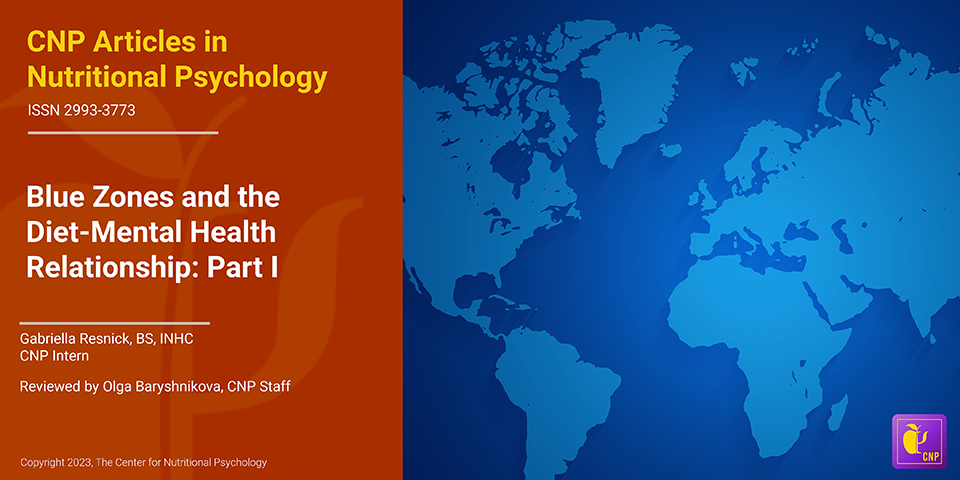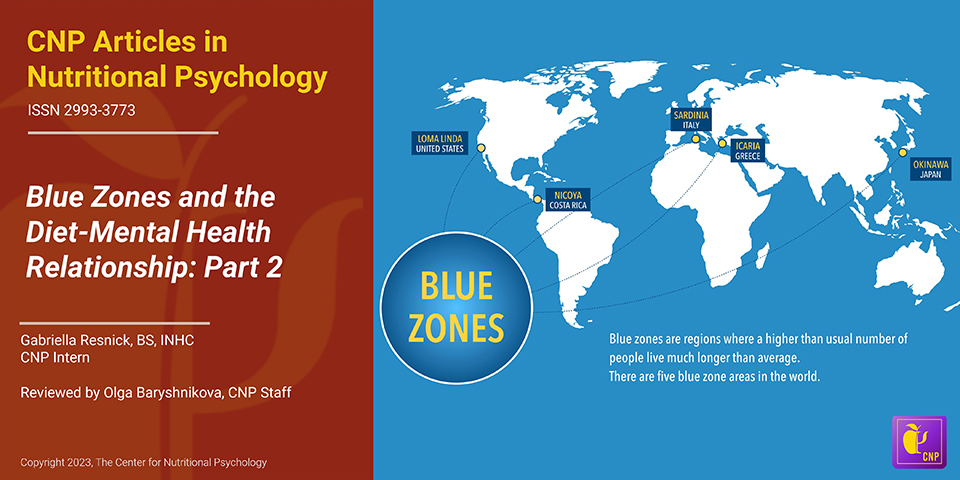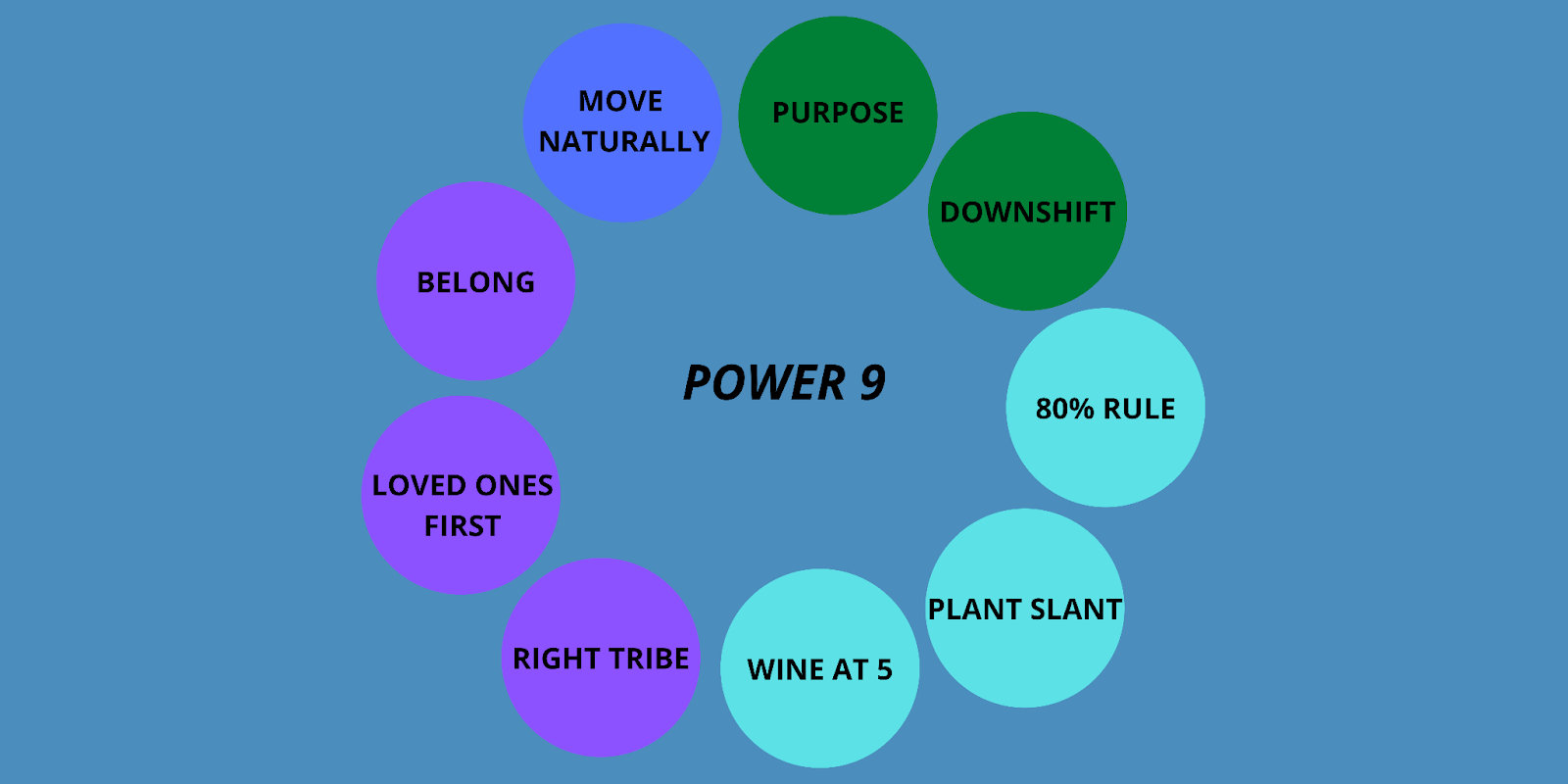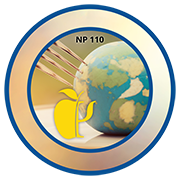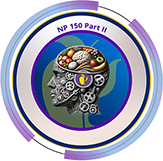Editor’s Note: This article, the second in this three-part series, dives deeper into the dietary habits of Blue Zone regions and highlights the physiological impact of nutrition on aging bodies. The next and final article will explore the interplay of diet and mental health in the context of abnormally aging populations.
As introduced in What is a Blue Zone, Blue Zones are geographic territories that produce abnormal numbers of centenarians: their residents are ten times more likely to reach age 100 than the average US citizen (Buettner & Skemp, 2016). These five regions — Ikaria, Greece; Okinawa, Japan; Sardinia, Italy; Loma Linda, California; and Nicoya, Costa Rica — encompass nine shared lifestyle characteristics that help explain exceptional longevity. These are called the Power 9 (Buettner & Skemp, 2016), and were reviewed in the previous article.
Blue Zone residents are ten times more likely to reach age 100 than the average US citizen.
Of these nine characteristics, food is involved in three — the 80% rule, plant slant, and wine at 5 — two of which speak to the actual dietary composition of Blue Zone meals. Evidence supports a correlation between healthy dietary patterns and a decreased risk of early death, begging the further inspection of diet as a factor in the atypical longevity of Blue Zone residents (Harmon et al., 2015).
When evaluating diet and its impact on longevity, nutritional epidemiologic studies have begun to assess populations through overall dietary patterns instead of tracking a single nutrient or food (Cespedes & Hu, 2015). Human beings do not habitually consume nutrients or food in isolation, and tracking dietary patterns produces a more realistic idea of how diet influences lifespan and health outcomes (Cespedes & Hu, 2015). Therefore, examining Blue Zones, we explore whole dietary patterns and their commonalities.

The traditional village of Evdilos, in Ikaria island, Greece. Courtesy of Shutterstock Images.
Ikarian cuisine largely revolves around Mediterranean diet principles (Buettner & Skemp, 2016). The Mediterranean diet is characterized by a high intake of fruits, vegetables, whole grains, legumes, herbs, and olive oil, a moderate intake of fish, poultry, dairy products, and red wine, and a low intake of sweets and red meat (Davis et al., 2015). Green vegetables and wild plants cooked in olive oil act as main meals rather than side dishes, complimenting the finding that Ikarian individuals’ fruit and vegetable consumption often exceeds dietary recommendations (Panagiotakos et al., 2011)
Green vegetables and wild plants cooked in olive oil act as main meals rather than side dishes.
Given their Mediterranean-inspired dietary habits, the high life expectancy of Ikarian individuals is not shocking. Adherence to a Mediterranean diet has been significantly associated with a reduced risk of mortality: 9% from cardiovascular disease, 6% from cancer, and 13% from Parkinson’s disease and Alzheimer’s disease (Sofi et al., 2008). Additionally, in an Ikarian-focused study, long-term fish consumption was independently associated with the improved kidney function of elders (Chrysohoou et al., 2013).
By growing much of their own diet, Ikarian individuals have been able to keep up with traditional Mediterranean eating habits into the 21st century, which may play a central role in their longevity (Legrand et al., 2021).

Okinawa, Japan. Courtesy of Shutterstock Images.
The traditional Okinawan dietary pattern is anchored majorly by root vegetables (specifically sweet potatoes), yellow and green leafy vegetables, legumes, and soy-based foods (Willcox et al., 2014). It emphasizes the intake of low-GI grains and high fiber-rich foods while stressing minimal consumption of meat and dairy products (Willcox et al., 2014). A typical meal includes miso-soup topped with tofu, fish, pork, or vegetables paired with fresh jasmine tea (medicinal plants hold significant importance to their diet) (Willcox et al., 2014).
Okinawan cuisine is largely plant-based, as staple foods there have always been locally grown due to financial strains (Willcox et al., 2014). Sweet potatoes in particular became a main source of caloric consumption due to their ability to survive severe climates (Willcox et al., 2014).
The high phytonutrient nature of the Okinawan diet may play a protective role in longevity, as antioxidants have the ability to buffer against oxidative stress: a set of chain reactions that impact the development of diseases such as arthritis, diabetes, dementia, and cancer (Tan et al., 2018; Willcox et al., 2013). The diet’s low glycemic load and low saturated fat content further reduce the known effects of oxidative stress (i.e., cardiovascular disease and other chronic illnesses), potentially aiding in the extension of Okinawan lifespans (Willcox et al., 2013).

Alley of Castelsardo old city in Sardinia, Italy. Courtesy of Shutterstock Images.
The classic Sardinian diet is considered a variant of the Mediterranean diet, as it stresses the consumption of carbohydrate foods and olive oil. However, it differs in its emphasis on meat (Pes et al., 2022). Sardinian dietary patterns, influenced by the city’s history of animal husbandry, involve the high consumption of animal products such as cheese, pork fat, and poultry meat (Pes et al., 2022). As sheep and goats contributed to Sardinia’s economic stability, dairy products such as soft sour cheeses are also prevalent (Pes et al., 2021).
Sardinian dietary patterns involve the high consumption of animal products such as cheese, pork fat, and poultry meat.
Positive associations between daily functioning and eating sheep, goat, and poultry meat have been found. The consumption of poultry alongside vegetables, for instance, is associated with a risk reduction of cardiovascular diseases, obesity, and type 2 diabetes mellitus (Marangoni et al., 2015; Pes et al., 2021). Additionally, the diet’s high antioxidant content, stemming largely from red wine, may impact lower cardiovascular mortality through compounds in the wine — resveratrol, and proanthocyanidins — that counteract age-related inflammation (Corder et al., 2006).

Costa Rica scenery, looking towards the Nicoya Peninsula from Monteverde. Courtesy of Shutterstock Images.
The general dietary pattern in Nicoya revolves around four foods eaten with high frequency: Gallo Pinto, tortillas de maiz, Cuajada, and Galla pinto con huevos (Nieddu et al., 2020). Popular dishes incorporate legumes, rice, potato, and cassava (a nutty-flavored, starchy root vegetable) (Link & Elliott, 2021; Pies et al., 2022). These carbohydrate-based foods have a low glycemic index, possibly promoting a delayed onset of various metabolic diseases (Rosero-Bixby et al., 2014). The frequent consumption of traditional foods such as rice and beans showcases an adherence to whole foods (Rosero-Bixby et al., 2013). While overall the residents of Nicoya eat a plant-based diet, the consumption of animal proteins is still relatively high. Nieddu et al. (2020) found that at least half of the oldest Nicoyans ate three to five servings of meat per week, and about 25% consumed meat daily.
While overall the residents of Nicoya eat a plant-based diet, the consumption of animal proteins is still relatively high.
Something unique to the Nicoya diet is the high calcium and magnesium content of their drinking water (Buettner & Skemp, 2016). This not only helps protect against heart disease but also promotes strong bones, a crucial component of healthy aging (Buettner & Skemp, 2016). Also notable is their high fruit consumption — mango and papaya specifically are known to promote high levels of antioxidants (Pes et al., 2022).

Loma Linda, California on a map. Courtesy of Shutterstock Images.
Loma Linda’s large Adventist community takes their diet directly from the Bible: they consume a largely vegetarian diet filled with leafy greens, nuts, and legumes (Buettner & Skemp, 2016). Fraser (1999) found that Adventist vegetarians eat an average of 3.5 servings of meat substitutes per week, often derived from soy, as well as copious amounts of fruit, which increases antioxidant and dietary fiber intake (Fraser, 1999).
This surge in dietary fiber through the consumption of vegetables, fruits, grains, and nuts is associated with lowered blood cholesterol and may offer protection against colon and rectal cancer, potentially explaining Loma Linda Adventists’ longevity (Howe et al., 1992; Soliman, 2019). The consumption of these foods combined with reduced meat intake may also decrease the risk of diabetes mellitus, hypertension, and arthritis (Fraser, 1999), facilitating healthier aging.
It is important to note that abstinence from smoking and generally limited alcohol intake might serve as confounding variables in exploring the longevity of Adventists (Montgomery et al., 2007). In other words, diet alone may not explain the above-average longevity of Adventists, as various lifestyle factors also impact healthful aging. Nonetheless, the lifespan for California Adventists is 7.3 years longer for men and 4.4 years longer for women than the general population in California, calling for the continued exploration of how diet influences abnormal aging (Fraser & Shavlik, 2001).
Overall Themes
What commonalities can we extract from the five independent Blue Zones? Each diet is influenced by unique religious, historical, cultural, and environmental factors, making it hard to combine them all under a single pattern (Pes et al., 2022). Nonetheless, there are a few takeaways we can make.
Each diet is influenced by unique religious, historical, cultural, and environmental factors, making it hard to combine them all under a single pattern.
First: the self-produced nature of the food consumed. Whether it be the fishermen of Ikaria catching the evening’s dinner or Okinawan elders growing yellow and green vegetables, much of the food prepared comes from local sources. This may be due to most of the Blue Zones’ more geographically isolated nature as well as financial constraints.
Second: the antioxidant-rich tendencies of the diets. Though from different sources (i.e., fruit in Nicoya, vegetation in Loma Linda, or wine in Sardinia), all the diets offer high amounts of antioxidants.
Third: the consumption of potatoes and carbohydrates with a low glycaemic index. If not low in the glycaemic index to begin with, the carbohydrates consumed are prepared in specific ways to lower the overall index (i.e., potatoes are boiled in Sardinia as opposed to fried).
Fourth: the inclusion of legumes and nuts. Though not all vegetarian, there are many plant-based themes among the five Blue Zone diets, including their use of legumes and nuts as protein sources.
What now?
It is clear that diet impacts longevity, as foods hold the power to either protect against or increase the risk of morbidity as well as health issues such as cardiovascular diseases, cancers, and arthritis. Knowing that nutrition impacts longevity from a physiological standpoint begs the question of how it indirectly influences longevity through its connection with mental health. The diet-mental health relationship within Blue Zone territories will be explored in this series’s third and final article.
References
Buettner, D., Skemp, S. (2016). Blue zones: lessons from the world’s longest lived. American Journal of Lifestyle Medicine, 10(5), 318-321. https://doi.org/10.1177/1559827616637066
Cespedes, E.M., Hu, F.B. (2015). Dietary patterns: from nutritional epidemiologic analysis to national guidelines. The American Journal of Clinical Nutrition, 101(5), 899-900.
https://doi.org/10.3945/ajcn.115.110213
Chrysohoou, C., Pitsavos, C., Panagiotakos, D., Skoumas, J., Lazaros, G., Oikonomou, E., Galiatsatos, N., Striggou, M., Xynogala, M., Stefanadis, C. (2013). Long-term fish intake preserves kidney function in elderly individuals: the Ikaria study. Journal of Renal Nutrition, 23(4), e75-e82. https://doi.org/10.1053/j.jrn.2012.09.002
Corder, R., Mullen, W., Khan, N.Q., Marks, S.C., Wood, E.G., Carrier, M.J., Crozier, A. (2006). Red wine procyanidins and vascular health. Nature, 556. https://doi.org/10.1038/444566a
Davis, C., Bryan, J., Hodgson, J., Murphy, K. (2015). Definition of the Mediterranean diet; a literature review. Nutrients, 7(11), 9139-9153. https://doi.org/10.3390/nu7115459
Fraser, G.E. (1999). Associations between diet and cancer, ischemic heart disease, and all-cause mortality in non-Hispanic white California seventh-day Adventists. The American Journal of Clinical Nutrition, 70(3), 532s-538s. https://doi.org/10.1093/ajcn/70.3.532s
Fraser, G.E., Shavlik, D.J.
(2001). Ten years of life: is it a matter of choice? Arch Intern Med, 161(13), 1645-1652. doi: 10.1001/archinte.161.13.1645
Harmon, B.E., Boushey, C.J., Shvetsov, Y.B., Ettienne, R., Reed, J., Wilkens, L.R., Marchand, L.L., Henderson, B.E., Kolonel, L.N. (2015). Associations of key diet-quality indexes with mortality in the multiethnic cohort: the dietary patterns methods project. The American Journal of Clinical Nutrition, 101(3), 587-597. https://doi.org/10.3945/ajcn.114.090688
Howe, G.R., Benito, E., Castelleto, R., Cornee, J., Esteve, J., Gallagher, R.P., Iscovich, J.M., Deng-ao, J., Kaaks, R., Kune, G.A., Kune, S., L’Abbe, K.A., Lee, H.P., Lee, M., Miller, A.B., Peters, R.K., Potter, J.D., Riboli, E., Slattery, M.L., Trichopoulos, D., Tuyns, A., Tzonou, A., Whittemore, A.S., Wu-Williams, A.H., Shu, Z. (1992). Dietary intake of fiber and decreased risk of cancers of the colon and rectum: evidence from the combined analysis of 13 case-control studies. Journal of the National Cancer Institute, 84(24), 1887-1896. https://doi.org/10.1093/jnci/84.24.1887
Larrson, S.C., Orsini, N. (2013). Red meat and processed meat consumption and all-cause mortality: a meta-analysis. American Journal of Epidemiology, 179(3), 282-289. https://doi.org/10.1093/aje/kwt261
Legrand, P., Nuemi, G., Poulain, M., Manckoundia, P. (2021). Description of lifestyle, including social life, diet and physical activity, of people ≥ 90 years living in Ikaria, a longevity blue zone. International Journal of Environmental Research and Public Health, 18(12), 6602. https://doi.org/10.3390/ijerph18126602
Link, R., Elliott, B. (2021). What is cassava? Health benefits and how to prepare it. Healthline. https://www.healthline.com/nutrition/tapioca#TOC_TITLE_HDR_5
Nieddu, A., Vindas, L., Errigo, A., Vindas, J., Pes, G.M., Dore, M.P. (2020). Dietary habits, anthropometric features and daily performance in two independent long-lived populations from Nicoya Peninsula (Costa Rica) and Ogliastra (Sardinia). Nutrients, 12(6), 1621. https://doi.org/10.3390/nu12061621
Marangoni, F., Corsello, G., Cricelli, C., Ferrara, N., Ghiselli, A., Lucchin, L., Poli, A. (2015). Role of poultry meat in a balanced diet aimed at maintaining health and wellbeing: an Italian consensus document. Food and Nutrition Research, 59(1). https://doi.org/10.3402/fnr.v59.27606
Montgomery, S., Herring, P., Beeson, L., Butler, T., Knutsen, S., Sabate, J., Chan, J., Fraser, G., Yancey, A., Preston-Martin, S. (2007). Comparing self-reported disease outcomes, diet, and lifestyles in a national cohort of Black and White seventh-day Adventists. Preventing Chronic Disease, 4(3), A62. PMCID: PMC1955428
Panagiotakos, D.B., Chrysohoou, C., Siasos, G., Zisimos, K., Skoumas, J., Pitsavos, C., Steganadis, C. (2011). Sociodemographic and lifestyle statistics of oldest old people (>80 years) living in Ikaria island: the Ikaria study. Cardiology Research and Practice, 2011: 679187. doi:10.4061/2011/679187
Passeri, G., Pini, G., Troiano, L., Vescovini, R., Sansoni, P., Passeri, M., Gueresi, P., Delsignore, R., Pedrazzoni, M., Franceschi. (2003). Low vitamin D status, high bone turnover, and bone fractures in centenarians. The Journal of Clinical Endocrinology & Metabolism, 88(11), 5109-5155. https://doi.org/10.1210/jc.2003-030515
Pes, G.M., Dore, M.P., Tsofliou, F., Poulain, M. (2022). Diet and longevity in the blue zones: a set-and-forget issue? Maturitas, 164, 31-37. https://doi.org/10.1016/j.maturitas.2022.06.004
Pes, G.M., Poulain, M., Errigo, A., Dore, M.P. (2021). Evolution of the dietary patterns across nutrition transition in the Sardinian longevity blue zone and association with health indicators in the oldest old. MDPI, 13(5), 1495. https://doi.org/10.3390/nu13051495
Rosero-Bixby, L., Dow, W.H., Rehkoph, D.H. (2013). The Nicoyan region of Costa Rica: a high longevity island for elderly males. Vienna Yearb Population Research, 11, 109-136. doi:10.1553/populationyearbook2013s109
Sofi, F., Cesari, F., Abbate, R., Gensini, G.F., Casini, A. (2008). Adherence to Mediterranean diet and health status: meta-analysis. British Medical Journal, 337, a1344. doi:10.1136/bmj.a1344
Soliman, G.A. (2019). Dietary fiber, atherosclerosis, and cardiovascular disease. Nutrients, 11(5), 1155. doi: 10.3390/nu11051155
Sotos-Prieto, M., Bhupathiraju, S.N., Mattei, J., Fung, T.T., Li Y., Pan, A., Willett, W.C., Rimm, E.B., Hu, F.B. (2017). Association of changes in diet quality with total and cause-specific mortality. The New England Journal of Medicine, 337, 143-153. DOI: 10.1056/NEJMoa1613502
Tan, B.L., Norhaizan, M.E., Liew, W.P.P., Rahman, H.S. (2018). Antioxidant and oxidative stress: a mutual interplay in age-related diseases. Frontiers in Pharmacology, 9, 1162. https://doi.org/10.3389/fphar.2018.01162
Willcox, D.C., Scapagnini, G., Willcox, B.J. (2014). Healthy aging diets other than the Mediterranean: a focus on the Okinawan diet. Mechanisms of Ageing and Development, 136-137, 148-162. https://doi.org/10.1016/j.mad.2014.01.002
Willcox, D.C., Willcox, B.J., Todoriki, H., Suzuki, M. (2013). The Okinawan diet: health implications of a low-calorie, nutrient-dense, antioxidant-rich dietary pattern low in glycemic load. Journal of the American College of Nutrition, 28(sup4), 500S-516S. https://doi.org/10.1080/07315724.2009.10718117
